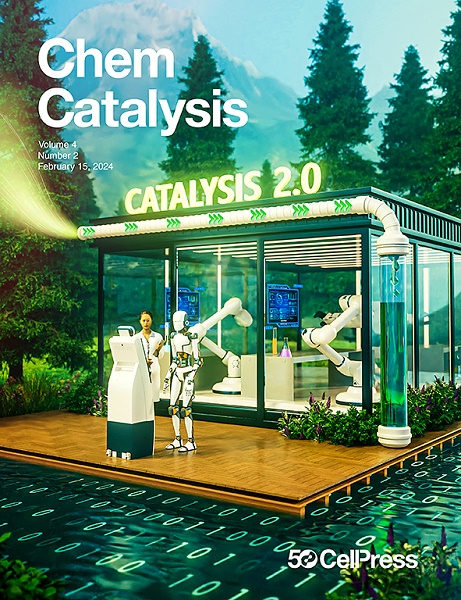通过数据分析和计算简化酶的发现和开发
IF 11.6
Q1 CHEMISTRY, PHYSICAL
引用次数: 0
摘要
在这里,我们报告了开发的酶,一个基于python的管道,用于分析高分辨率的液相色谱-质谱(LC-MS)数据,专门为生物催化实验量身定制。将酶应用于Fe(II)/α-酮戊二酸依赖的卤化酶WelO5 *变体对抗真菌大环内酯soraphen A的生物催化反应中,我们发现了使用标准分析软件时未观察到的反应结果。有趣的是,我们检测到先前未报道的sorphena选择性氧化去甲基化以及报道的羟基化和氯化。在这一发现的基础上,一种计算指导的蛋白质工程方法使我们能够通过仅创建和测试三个预测变体来识别WelO5 *变体,该变体表现出3倍的去甲基化性能。总之,我们展示了酶工作流程的实用性及其快速检测以前未观察到的生物催化产物的潜力,并强调了数据科学管道和酶的计算设计之间有价值的协同作用。本文章由计算机程序翻译,如有差异,请以英文原文为准。

Streamlining enzyme discovery and development through data analysis and computation
Here, we report the development of EnzyMS, a Python-based pipeline for the analysis of high-resolution liquid chromatography-mass spectrometry (LC-MS) data specifically tailored for biocatalysis experiments. Applying EnzyMS to biocatalytic reactions carried out with variants of Fe(II)/α-ketoglutarate-dependent halogenase WelO5∗ on the antifungal macrolide soraphen A, we discovered reaction outcomes that had not been observable when using standard analysis software. Interestingly, we detected a previously unreported selective oxidative demethylation of soraphen A alongside the reported hydroxylations and chlorinations. Building on this finding, a computationally guided protein engineering approach allowed us to identify a WelO5∗ variant that exhibited a 3-fold improved demethylation performance by only creating and testing three predicted variants. In summary, we showcase the utility of the EnzyMS workflow and its potential to enable rapid detection of previously unobserved biocatalytic products and highlight the valuable synergies between data science pipelines and the computational design of enzymes.
求助全文
通过发布文献求助,成功后即可免费获取论文全文。
去求助
来源期刊
CiteScore
10.50
自引率
6.40%
发文量
0
期刊介绍:
Chem Catalysis is a monthly journal that publishes innovative research on fundamental and applied catalysis, providing a platform for researchers across chemistry, chemical engineering, and related fields. It serves as a premier resource for scientists and engineers in academia and industry, covering heterogeneous, homogeneous, and biocatalysis. Emphasizing transformative methods and technologies, the journal aims to advance understanding, introduce novel catalysts, and connect fundamental insights to real-world applications for societal benefit.

 求助内容:
求助内容: 应助结果提醒方式:
应助结果提醒方式:


